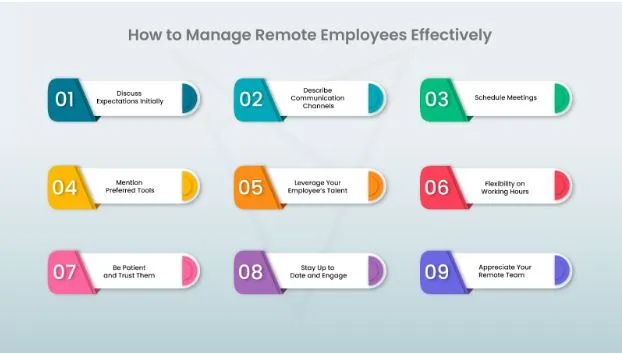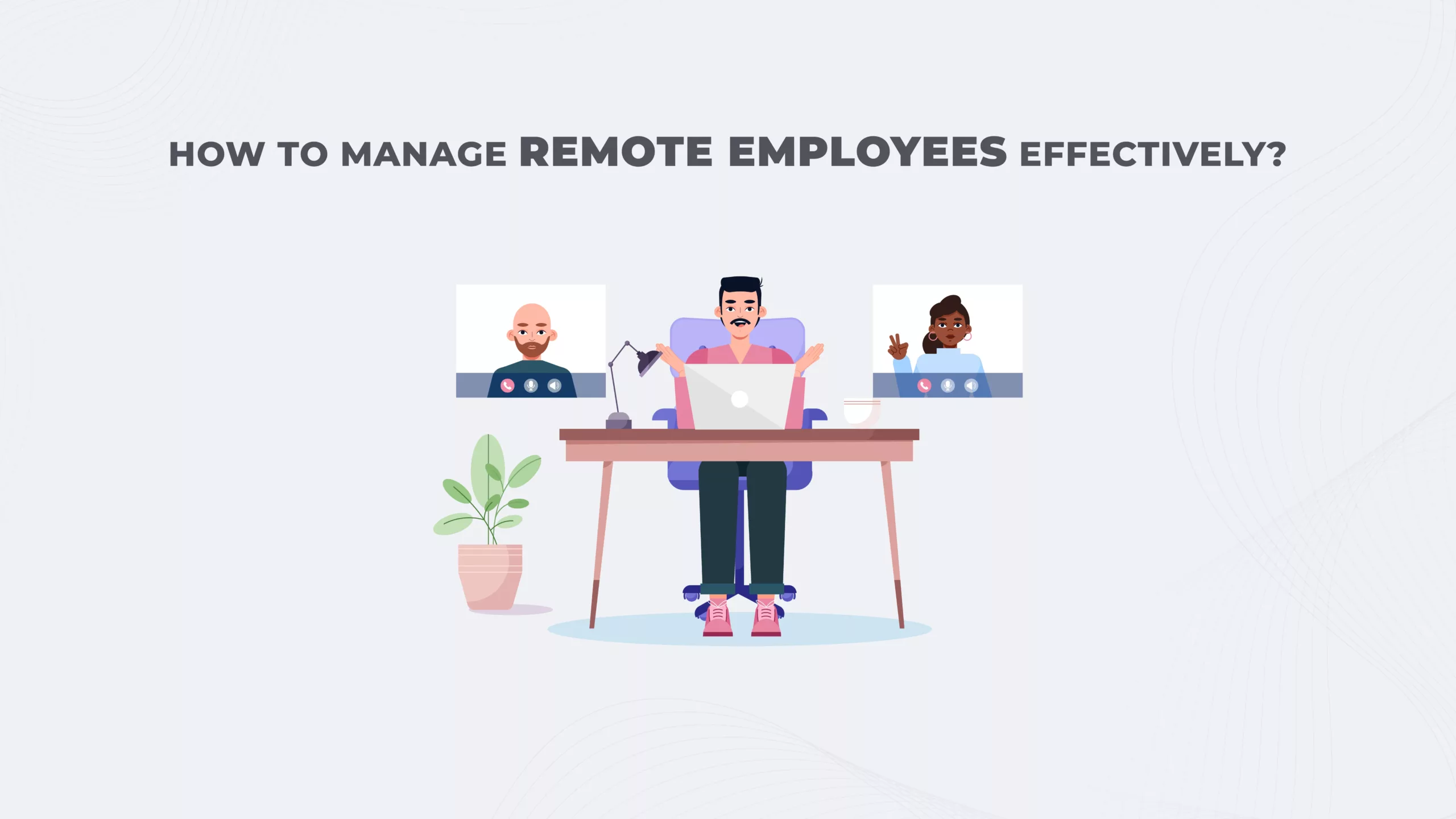In today’s digital age, remote work has become increasingly popular,with a whopping 26% of American residents working remotely as of 2022, according to Zippia. This shift from traditional on-site jobs to remote work offers many benefits to employers. However, managing remote employees can also present challenges too.
In this article, we’ll provide you with valuable insights and actionable tips on how to manage remote employees. Whether you’re new to remote work or looking to improve your existing processes, this guide will help you stay organized, maintain open communication, and ensure your team is operating at their best.
So, without further delay, let’s get started.
9 Practical Tips to Manage Remote Employees Effectively

Discuss Expectations Initially
When hiring a remote employee, it’s essential to set clear expectations from the start to ensure that they know what’s expected of them. Start by explaining your company’s policies and rules, as well as your expectations for output and deadlines. It’s also important to communicate any strict response time or follow-up requirements.
Don’t assume that your employee will understand everything just by reading guidelines. Especially if you are using software like property management software like those in the property industry do for instance. Take the time to explain everything in detail and ask them if they have any questions or concerns. Disappointment with their output can be avoided by clarifying everything upfront.
By setting expectations clearly and communicating regularly, you can ensure that your remote employee feels supported and motivated to do their best work. This will not only benefit your organization but also help your new hire thrive in their role.
Discuss Communication Channels

Communication is one of the biggest hurdles when managing people remotely. Unlike in-person communication, remote work requires solid communication channels to convey daily tasks, discuss project details, and ensure everyone is on the same page. But with multiple communication modes available, how do you know which one is right for you and your team?
Email is one of the most used communication channels professionally. Initially, you can go with the email exchange. To manage the remote team efficiently, you might have to switch to the options below.
Messaging App
Besides email, you can choose a messaging app for your company. Slack or Microsoft Teams are a good example. They allow for quick and easy communication, file sharing, and collaboration. You can even set up channels for different teams, projects, and topics to keep everyone organized and updated.
Phone Call
For lengthy conversations, messaging can consume a chunk of your time. For situations that require a more detailed explanation or discussion, consider using phone calls. It allows for a more personal touch and is great for building relationships with team members.
Video Call
Let’s admit that you might be able to wire information through a phone call. It doesn’t offer that face-to-face conversational touch. So, we suggest having a video call with your remote employees. Video calls are perfect for team meetings, one-on-one check-ins, and team building exercises.
Schedule Meetings

Meetings are an essential part of managing a remote workforce. It helps you discuss the projects you are working on and the ones in the pipeline.
However, arranging on-site meetings in a remote work setting is not always the best practice. Your team members may not be available, or unexpected circumstances might arise, making it impossible to hold a meeting. This can cause confusion, delays, and setbacks in your team’s productivity.
To avoid these challenges, it’s crucial to schedule meetings in advance. By doing so, you can ensure that everyone is available and prepared to participate. Scheduling meetings also helps you manage your time effectively.
Take note that you should always treat all your employees equally in a group meeting. This will build your employee’s trust level and confidence in you.
Mention Preferred Tools
Every company uses different tools to make its working cycle smooth. One efficient tip for managing remote employees easily is to tell them your organization’s preferred tools. There are some designations that require paid tools to get started on working. It’s also your responsibility to provide your remote employee premium tools – if required.
For instance, if your remote employee is a content writer, they should have access to Grammarly premium for grammar checks. Similarly, Your remote SEO expert may require access to Ahrefs, SEMRush or similar tools.
Besides tools, you should also use project spreadsheets to effectively manage and keep the projects and your remote staff’s work in check. This will help you in remote worker management.
Leverage Your Employee’s Talent
Every company has its own methods of working while an employee can have his own style. But this doesn’t mean to hinder or to keep your remote employees from putting their insights. To effectively manage a remote team, it’s important to involve your remote employees in conversations and decision-making.
By doing so, you can gain new perspectives and ideas from fresh eyes and minds, and tap into their expertise and knowledge of their designated areas. It also helps to create an environment of inclusivity and collaboration, where everyone feels valued and heard.
Flexibility on Working Hours

As a manager, one of your goals is to optimize your team’s productivity, and with remote work becoming more common, it’s essential to shift your focus to outputs instead of just ensuring your employees sit at their desks for a set number of hours.
By embracing remote work, you’re allowing your team members to work in a way that suits them best. This flexibility can be a powerful motivator, as it enables your employees to schedule their work around their personal lives.
To achieve optimal productivity with your remote employees, it’s essential to communicate clearly and establish expectations for deliverables and timelines. When your employees feel trusted and empowered to manage their work independently, they’ll be more engaged, productive, and satisfied with their jobs.
Must Read: The 10 Top Benefits of Outsourcing Application Development
Be Patient and Trust Them

Managing remote employees require a unique set of skills, and patience is undoubtedly one of them. When you onboard new remote employees, you may face challenges such as time zone differences and internet connectivity issues. However, as a manager, you should remain calm and patient when communicating with your team.
Along with being patient, you should also trust your employees, so they reciprocate the act. A trust level between you and your client will ease your communication in the long run.
Assuming you as their coach, your employees should get back to you if an odd situation arises. Remember, the best managers are always good listeners, counselors, and the right decision-makers.
Explain to them the details of a specific project and give them a free hand on it. This will allow them to be creative and develop trust. Otherwise, your project output might not be as exclusive as you want it to be.
Stay Up to Date and Engage

As a manager, keep yourself and the team up to date. Keep track of your remote employees’ progress, and regularly communicate with them to discuss their work. It’s also essential to inform your team of any changes in company policy or successful projects.
Providing your remote employees with the necessary resources and deadlines is crucial for project completion. While work is important, it’s also crucial to provide emotional support to your remote team. Be a listening ear and offer support whenever possible.
Discover more about your employees so you can sync your management style with their attitude. This will bring efficient results and outlook to your projects and your business.
Appreciate Your Remote Team

When managing a remote team, one thing that needs constant attention is tracking progress. Keep an eye on your employees’ performance. Make a weekly or biweekly progress report of the projects they have worked on, their quality and their impact on clients. Additionally, you should notice if they are completing the projects on time.
If the employees have shown positive results for the company and you are satisfied with the results, appreciate them. In contrast, explain to them your expectations and tell them how they can do better to meet them if they lack.
Must Read: How to choose an Outsourcing Partner for Software Solutions
Conclusion
To help you manage remote teams efficiently, today, we discussed the best practices for managing remote teams. First thing first, clearly communicate your expectations to your team and establish proper communication channels, schedule meetings, and provide access to important tools.
Encourage your remote employees to contribute their unique insights and be flexible with their work schedule. Trust your team to do their best work and show patience when engaging with them.
Lastly, recognize and appreciate your team’s performance regularly to motivate them to continue producing great work. By following these practical tips, you’ll be on your way to managing remote teams efficiently and effectively.



